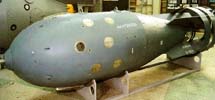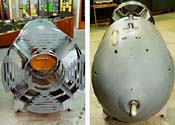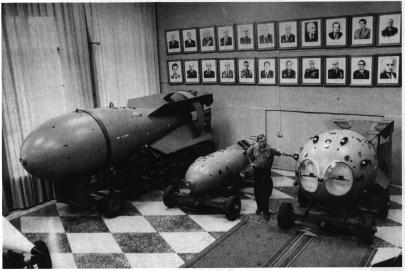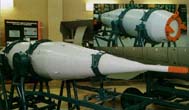 First Soviet Tactical Atomic Bomb (30 K)
First Soviet Tactical Atomic Bomb (30 K)
 First Soviet Tactical Atomic Bomb (47 K)
First Soviet Tactical Atomic Bomb (47 K)





The Russian Atomic Weapon Museum is located at Sarov (formerly Arzamas-16), the principal Soviet nuclear weapon laboratory, some 400 km east of Moscow. Ths museum was inspired and modelled on the U.S. National Atomic Museum.
In the picture below, the weaponized version of the 20 Kt Joe-1 (the first Soviet atojmic weapon) can be seen at right and the weaponized version of the 400 Kt Joe-4 (the thermonuclear "Sloika" device) on left. In the middle is the 40 Kt improved implosion bomb Joe-2, tested 24 September 1951 at 38 Kt.
 Arzamas-16 Bomb Museum (23 K)
Arzamas-16 Bomb Museum (23 K)
Click here to see a large picture of the museum displays (139 K)
 Khariton with the weaponized Joe-1 in 1992 (25 K)
Khariton with the weaponized Joe-1 in 1992 (25 K)
Tested in 1953 at the Semipalatinsk test range (this was no doubt Soviet Test No. 5, an airburst conducted 23 August 1953 with a yield of 28 Kt). Deployed yield up to 30 Kt. In service from 1954 to 1965.
This bomb casing looks very similar to Joe-2 shown in the museum display above. It is clearly not the same exhibit, since the supporting mount is different.
 First Soviet Tactical Atomic Bomb (30 K)
First Soviet Tactical Atomic Bomb (30 K)
 First Soviet Tactical Atomic Bomb (47 K)
First Soviet Tactical Atomic Bomb (47 K)
Pictures courtesy Russia's Arms Catalog by Zigzag Publishing Group.
Up to 10 kiloton yield. Maximum range 32 km. In service from 1960 to 1967.
 First Soviet Tactical Missile Nuclear Warhead (39 K)
First Soviet Tactical Missile Nuclear Warhead (39 K)
Picture courtesy Russia's Arms Catalog by Zigzag Publishing Group.
Pictures courtesy Russia's Arms Catalog by Zigzag Publishing Group.
Above are pictures of the warhead for the first Soviet ICBM, the SS-6 "Sapwood" (oofical Soviet designation "R-7" or "8-K-3"). The "Sapwood" carried a heavy 10,000 lb. three-megaton warhead and on its 21 August 1957 test flight flew 4,000 miles from Kazakhstan into the western Pacific Ocean. The SS-6 was deployed in 1958 and had a range of 8,500 kilometers (5,270 statute miles).
The "Sapwood" warhead was probably first tested in Soviet test No. 47, on 6 October 1957. This test conducted at the Novaya Zemlya Test Range was a 2.9 megaton airburst. This was the largest Soviet test up to that time, and only the third Soviet test in the megaton range. Additional tests in 1958 with yields of 2.9 and 2.8 Mt (18 October 1958 and 22 October 1958 respectively) may also have been tests of this design.
Time: 30 October 1961
Location: Parachute retarded airburst, 4000 m altitude
Over Novaya Zemlya Island test range (in the Arctic Sea)
Yield: 50 Megatons
Shown here in the Russian Atomic Weapon Museum, the "Tsar Bomba" was the largest nuclear weapon ever constructed or detonated. This three stage weapon was actually a 100 megaton bomb design, but the uranium fusion tamper of the teritiary (and probably secondary) stage(s) was replaced by one made of lead to eliminate fast fission by the fusion neutrons. The result was also the cleanest weapon ever tested with 97% of the energy coming from fusion reactions.
This weapon was developed in a remarkably short time. On 10 July 1961 Nikita Khruschev met with Sakharov, then the senior weapon designer, and directed him to develop a 100 megaton bomb. This device had to be ready for a test series due to begin in September so that the series would create maximum political impact (a bomb this size is virtually useless militarily). Sakharov returned to Arzamas-16, and selcted a design team consisting of Victor Adamskii, Yuri Babaev, Yuri Trunev, and Yuri Smirnov (who later oversaw the transformation of this design into a fielded weapon). The bomb was tested only 14 weeks after the initiation of its design.
The effect of this bomb at full yield on global fallout would have been tremendous. It would have increased the world's total fission fallout since the invention of the atomic bomb by 25%. The fabrication of the massive parachute disrupted the Soviet nylon hosiery industry. It weighed 27 metric tons. Some were actually stockpiled.
The bomb was air dropped by a Tu-95 strategic bomber piloted by A. E. Durnovtsev (made Hero of the Soviet Union).
The nickname Tsar Bomba is a reference to the Russian proclivity for making gigantic but useless artifacts for show. The world's largest bell (the Tsar Kolokol) and cannon (the Tsar Pushka), neither of which are actually useful for anything, are on display at the Kremlin.
This single warhead missile is currently (late 1997) the only strategic nuclear delivery system in production in Russia. The original version of the SS-25 (RS-12M) went into service in 1985. The current RT-2PM model was first test flown 20 December 1994. It is built by the Moscow Institute of Thermal Technology and assembled at Votkinsk. It differs from the earlier SS-25 in that all of the missile is now made in Russia. The current version is road-mobile, but a silo-based version (the Topol M) is being developed. The Topol is perhaps also the only ICBM currently in production in the world, and the Topol M may be the only ICBM under development (depending on what the Chinese are doing).
Current strategic plans are to continue the manufacture of the SS-25 to replace most of the ICBMs currently in service (currently at the low production rate of about 1 per month). There are currently about 369 in service (as of December 1996).
The Topol has a range of 10,500 km, and a payload of 1000 kg. It is aremd with a single 550 Kt warhead with an accuracy (CEP - circular error probability) of 200 m.
Below is a pciture from the early 90s showing a Soviet/Russian tactical nuclear warhead being loaded in the field.